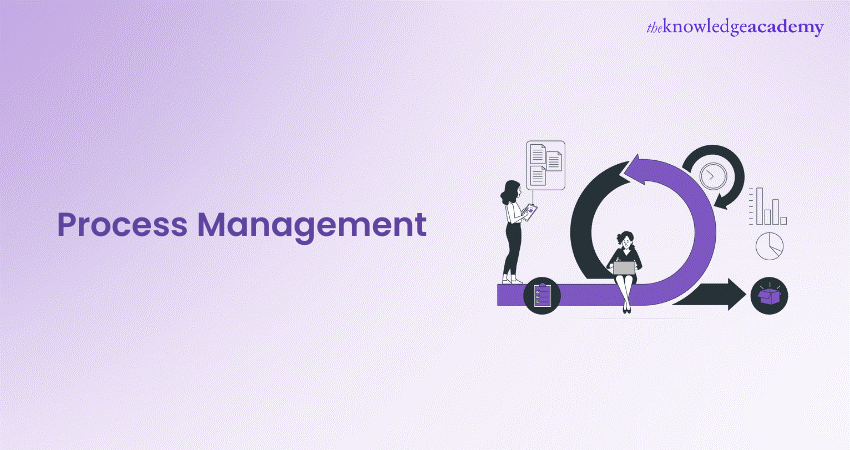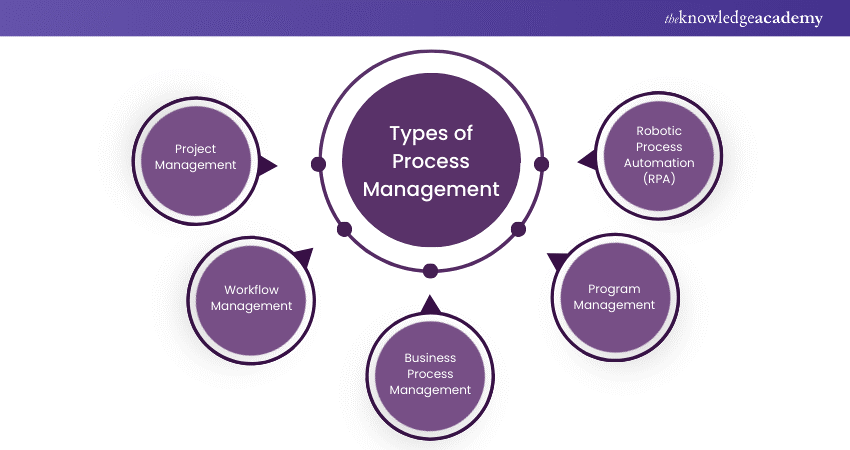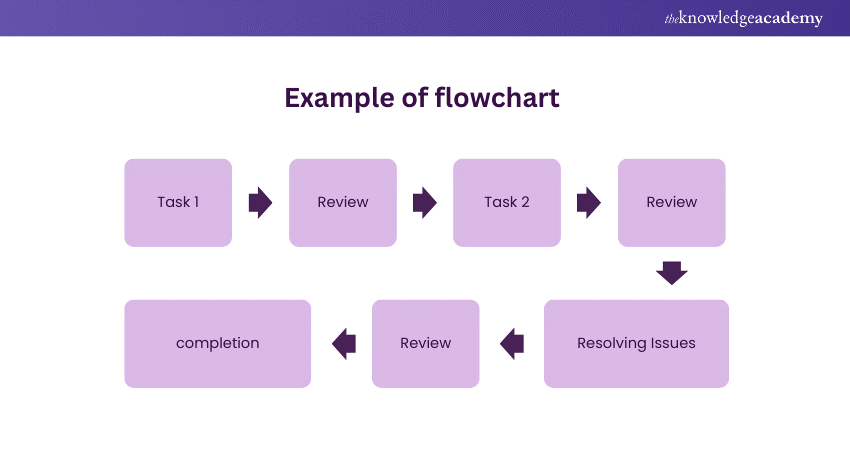We may not have the course you’re looking for. If you enquire or give us a call on +91-181-5047001 and speak to our training experts, we may still be able to help with your training requirements.
Training Outcomes Within Your Budget!
We ensure quality, budget-alignment, and timely delivery by our expert instructors.

Process Management helps organise and align business efforts, increases workflow efficiency, and reduces unwanted steps in the operation. To do so, Process Managers use a set of strategies that increase productivity. This blog will further explain the types, utilising processes, and possible challenges while implementing Process Management.
Table of Contents:
1) What is Process Management?
2) Types of Process Management
3) Tips for Process Management
4) Utilising Process Management effectively
5) Examples of Process Management models
6) Establishing a Process Management system
7) Real-life instances of Process Management
8) Benefits of Process Management
9) Challenges in implementing a new Process Management System
10) Conclusion
What is Process Management?
Process Management helps achieve long-term goals by implementing strategic organisation of the tasks involved in processes. Process Managers aim to align processes with the company's vision and targets, standardise, and optimise simple repetitive tasks. Here are some types of Process Management you can implement if you are a Process Manager.
Types of Process Management

Here are some types of Process Management you can implement if you are a Process Manager:
1) Project Management
This type of Process Management focuses on a singular project to effectively complete it within the agreed-on budget in a predefined time frame. Here, the Process Manager strategically plans how to deliver the project most effectively without losing the integrity of the end product.
2) Workflow Management
In workflow management, the Process Manager focuses on coordinating and optimising tasks and activities. They ensure that the work is divided among the team efficiently, all the necessary steps are completed, and deadlines are met on time.
3) Business Process Management
This type of Process Management focuses on all the different departments and functions within the organisation. The aim is to optimise all the processes of the organisation to enhance the company’s efficiency. Business Process Management software can assist this type of Process Management.
4) Program Management
Program Management is a type of Process Management that manages multiple related projects simultaneously. It involves coordinated efforts of planning, executing, and monitoring several projects, ensuring that they align with the strategic goals.
5) Robotic Process Automation (RPA)
In the new generation of technology, it's no secret that companies use certain bots to assist the workflow. RPA is a type of Process Management that does just that. It uses software bots to automate repetitive tasks that can be easily performed by an AI bot with the right prompts. These bots are designed to enhance accuracy, efficiency, and speed by minimising errors that would occur with manual intervention.
Tips for Process Management
Entering the world of Process Management can be hectic, as it is your responsibility to ensure each element of the process goes smoothly. Here are some tips for you to navigate through the stormy waters:
1) Craft a Flow Diagram
Creating flow charts to establish a workflow can be extremely beneficial to the process. A flow chart is a visual representation of the business process from start to finish. It gives an idea of how simple or complex the operation is, which would help determine the time required for each task.
Are you new to the world of management? Sign up for our Management Training For New Managers Course!
2) Assess Process Success
It is essential to evaluate the process to determine the operation's success. Here are some things to keep in mind while assessing the process:
a) If the process matches the needs of the client.
b) Would the process generate the desired results?
c) Is the process automated or manual?
d) Does the process require collaborative efforts? If yes, who are the people who would be involved?
e) Can the process be measured and documented for transparency?
3) Prioritise Communication
A process requires several people to collaborate to make it a success. Hence, it is essential to prioritise communication, as miscommunication between the team working on the process can make or break the entire operation.
Utilising Process Management Effectively
To successfully implement Process Management strategies, here are a few things you can do:
1) Align with Organisational Goals
While planning the process's structure, it's essential to consider the organisational goals. Apart from delivering the desired work to the client, the organisation must maintain standards that cater to its long-term goals. It is up to the Process Manager to ensure the process aligns with the company’s goals.
2) Establish Reliable Processes
To match the company's productivity needs, it is important to establish a reliable process for the team to adapt to. This will speed up the process and help maintain consistency.
Are you Managing a team remotely? You can do it better! Sign up for our Managing Remote Teams Course!
3) Consider Available Resources
While planning any process to be executed, it is important to consider the available resources, such as budget and manpower. This would prevent being left shorthanded on tasks and exceeding budget unnecessarily.
Examples of Process Management models
You are free to choose how you wish to model your processes. However, here are some examples you can use as reference:
1) Flow Charts
As mentioned, flow charts offer a visual representation of the process for everyone to comprehend easily. They also establish a chain of flow to follow to complete the tasks at hand and facilitate an easy transition from one task to another.

2) Business Process Modelling Notation (BPMN)
Created by Object Management Group, BPMN is a model that uses graphical notations to map out business processes. They aim to simplify the most complex processes to be easily comprehended by everyone in the team.
3) Gantt Charts
Created by the American mechanical engineer Henry Gantt, Gantt charts manage time-sensitive tasks. They use bars to track task progress sequentially, helping you understand where the team may lag.
4) Data Flow Diagrams (DFDs)
Data flow diagrams also allow you to visualise the process as data streams. Like flow charts, DFDs have more extensive keys and commands that will enable you to customise your organisation with different shapes and colours.
Establishing a Process Management System
If you wish to know how to establish a Process Management system, don't worry! Just follow the mentioned steps, and you should be able to manage the processes successfully like a pro!
1) Define Goals and Objectives Clearly
Establish the process's goals and objectives. This is the most crucial first step, as it defines the direction of the process. Once you set the foundation, you are ready to map its progression.
2) Map the Existing Processes
Document the progression of the process, including the steps to follow, the inputs to add, the outputs to obtain, etc. Make sure to keep the stakeholders involved in this process, as they will have valuable input to deliver their preferred outcomes.
3) Identify Opportunities to Improvement
In any field or process, there is always scope to improve! To keep up with growing trends and stay a step ahead of the competitors, you need to be able to identify opportunities to succeed. You can do so by evaluating the effectiveness and efficiency of the process and the performance on each task. Track the progress and see how you can make it better.
4) Optimise the Processes
Once you’ve understood how to make the process more effective, the next step is to implement the changes to optimise it. You can do so by eliminating unnecessary steps, automating repetitive tasks, redefining the roles and responsibilities, etc.
Real-life instances of Process Management
If you are curious about what situations you would be required to manage as a Process Management, here are a few examples for you:
1) Loan Processing
If you work at a banking firm, Process Management will simplify the loan process. It will make it easy for users to apply for loans. It would further simplify the process of verifying the credit score, checking risks, and finally, the approval process.
2) Compliance Management
In insurance companies, Process Management would assist compliance management by reducing human errors. Proper documentation management will prevent data loss. It would also help categorise compliances and verify the legitimacy of claims.
3) Customer service
The retail and services industries could use Process Management to cater to better customer service. Automating the process would reduce their need for more customer service employees.
4) Onboarding new employees
If you’re a Human Resource executive, you can automate the onboarding process for new joiners by creating a platform for them to apply and software to assess their resumes based on the requirements to help shortlist candidates.
5) Managing logistics
In shipping companies, there is extensive data on locations for pick-up and delivery. There is also a lot of manual intervention that may result in human errors. Process Management can organise the logistics to avoid human errors as much as possible, making the job less complicated.
Benefits of Process Management
Process Management is highly beneficial to functional businesses. Here’s how:
1) Minimised risks: It helps in eliminating human error and maximising consistency, Process Management minimises the possible risks involved in the process.
2) Reduced costs: It reduces costs by automating processes, companies require lesser manpower to complete tasks. Additionally, it reduces the resources required by computing the exact requirement of resources.
3) Streamlined processes: It streamlines the process for easy access and comprehension.
4) Increased productivity: It increases productivity by atomising certain tasks. The automated tasks are also time efficient as the computer performs them almost instantly, where as a human would take a few hours for the same.
5) Enhanced customer service: By automating customer services, it delivers quick and easy resolutions for complaints and maintains consistency in the service.
Challenges in Implementing a New Process Management System
1) Limited resources: The computed resources may be limiting for employees to work with as it may not take into consideration the variables that may intervene.
2) Resistance to change: Some employees may not be comfortable with the changes made to the organisation of processes as it can be hard to get accustomed to.
3) Lack of buy-in: To successfully implement the stakeholders need to be convinced of its value, which can affect the chances of it being considered.
4) Integration with existing systems: Companies who may already have other systems in play to integrate a new system might find implementation problematic.
Want to be a contributing member to your organisational growth? Sign up for our Personal & Organisational Development Training!
Conclusion
This blog discussed Project Management and its types. It also gave you a few tips on how to implement it, followed by a step-by-step process. Further, it examines the real-life applications of Process Management. Additionally, it listed some of its advantages and challenges you may have while implementing it.
Frequently Asked Questions

To simplify the processes by organising and automating repetitive tasks. Aiding the smooth sailing of the workflow and minimising the risks involved. Additionally, create a structure that helps maintain consistency.

Process Management is also widely called BPM, which stands for Business Process Management.

The Knowledge Academy takes global learning to new heights, offering over 30,000 online courses across 490+ locations in 220 countries. This expansive reach ensures accessibility and convenience for learners worldwide.
Alongside our diverse Online Course Catalogue, encompassing 17 major categories, we go the extra mile by providing a plethora of free educational Online Resources like News updates, Blogs, videos, webinars, and interview questions. Tailoring learning experiences further, professionals can maximise value with customisable Course Bundles of TKA.

The Knowledge Academy’s Knowledge Pass, a prepaid voucher, adds another layer of flexibility, allowing course bookings over a 12-month period. Join us on a journey where education knows no bounds.

The Knowledge Academy offers various Business Skills, including 8D Problem-Solving Training, Absence Management and Managing Behaviour Training Course, and Anti-Social Behaviour Management Training. These courses cater to different skill levels, providing comprehensive insights into Business Skills methodologies.
Our Business Skills Blogs cover a range of topics related to Leadership, offering valuable resources, best practices, and industry insights. Whether you are a beginner or looking to advance your Project Management skills, The Knowledge Academy's diverse courses and informative blogs have you covered.
Upcoming Business Skills Resources Batches & Dates
Date
 Introduction to Management
Introduction to Management
Fri 20th Dec 2024
Fri 14th Feb 2025
Fri 11th Apr 2025
Fri 13th Jun 2025
Fri 8th Aug 2025
Fri 10th Oct 2025
Fri 12th Dec 2025







 Top Rated Course
Top Rated Course



 If you wish to make any changes to your course, please
If you wish to make any changes to your course, please


